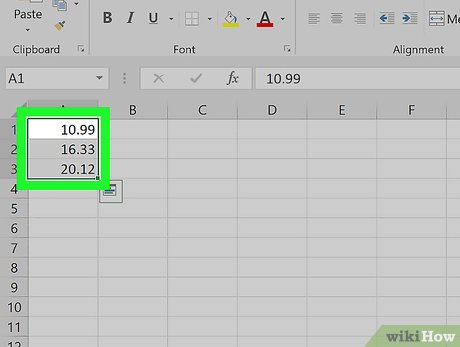How to Round in Excel
Method 1 of 3:
Using the Increase and Decrease Decimal Buttons
-
 Enter the data into your spreadsheet.
Enter the data into your spreadsheet. -
 Highlight any cell(s) you want rounded. To highlight multiple cells, click the top left-most cell of the data, then drag your cursor down and to the right until all cells are highlighted.
Highlight any cell(s) you want rounded. To highlight multiple cells, click the top left-most cell of the data, then drag your cursor down and to the right until all cells are highlighted. - Click the Decrease Decimal button to show fewer decimal places. It's the button that says .00 → .0 on the Home tab on the 'Number' panel (the last button on that panel).
- Example: Clicking the Decrease Decimal button would change $4.36 to $4.4.
- Click the Increase Decimal button to show more decimal places. This gives a more precise value (rather than rounding). It's the button that says ←.0 .00 (also on the 'Number' panel).
- Example: Clicking the Increase Decimal button might change $2.83 to $2.834.
Method 2 of 3:
Using the ROUND Formula
- Enter the data into your spreadsheet.
- Click a cell next to the one you want to round. This allows you to enter a formula into the cell.
- Type 'ROUND' into the 'fx' field. The field is at the top of the spreadsheet. Type an equal sign followed by 'ROUND' like this: =ROUND.
- Type an open parenthesis after 'ROUND.' The content of the 'fx' box should now look like this: =ROUND(.
- Click the cell that you want to round. This inserts the cell's location (e.g., A1) into the formula. If you clicked A1, the 'fx' box should now look like this: =ROUND(A1.
- Type a comma followed by the number of digits to round to. For example, if you wanted to round the value of A1 to 2 decimal places, your formula would so far look like this: =ROUND(A1,2.
- Use 0 as the decimal place to round to the nearest whole number.
- Use a negative number to round by multiples of 10. For example, =ROUND(A1,-1will round the number to the next multiple of 10.
- Type a closed parenthesis to finish the formula. The final formula should look like this (using the example of rounding A1 2 decimal places: =ROUND(A1,2).
- Press ↵ Enter or ⏎ Return. This runs the ROUND formula and displays the rounded value in the selected cell.
- You can replace ROUND with ROUNDUP or ROUNDDOWN if you know you want to round up or round down to a certain number of decimal points.[1]
- Similarly, the formula MROUND will round to the nearest multiple of any specified number.[2]
Method 3 of 3:
Using Cell Formatting
- Enter your data series into your Excel spreadsheet.
- Highlight any cell(s) you want rounded. To highlight multiple cells, click the top left-most cell of the data, then drag your cursor down and to the right until all cells are highlighted.
- Right-click any highlighted cell. A menu will appear.
- Click Number Format or Format Cells. The name of this option varies by version.
- Click the Number tab. It's either on the top or side of the window that popped up.
- Click Number from the category list. It's on the side of the window.
- Select the number of decimal places you want to round to. Click the down-arrow next to the 'Decimal places' menu to display the list of numbers, then click the one you want to select.
- Example: To round 16.47334 to 1 decimal place, select 1 from the menu. This would cause the value to be rounded to 16.5.
- Example: To round the number 846.19 to a whole number, select 0 from the menu. This would cause the value to be rounded to 846.
- Click OK. It's at the bottom of the window. The selected cells are now rounded to the selected decimal place.
- To apply this setting to all values on the sheet (including those you add in the future), click anywhere on the sheet to remove the highlighting, and then click the Home tab at the top of Excel, click the drop-down menu on the 'Number' panel, then select More Number Formats. Set the desired 'Decimal places' value, then click OK to make it the default for the file.
- In some versions of Excel, you'll have to click the Format menu, then Cells, followed by the Number tab to find the 'Decimal places' menu.
Update 05 March 2020
You should read it
- Round a number in Excel
- Round a number in Excel (ROUND function)
- The round () function in Python
- Ways to round numbers in Excel
- ROUND, ROUNDDOWN, ROUNDUP functions - Functions for rounding decimal numbers in Excel
- Instructions for rounding decimal numbers after commas in Excel
- How to round numbers in Excel using the ROUND, ROUNDUP, ROUNDDOWN Function
- Round function, how to use rounded functions in Excel
- ROUND function in SQL Server
- How to Convert from Binary to Decimal
- TIMEVALUE function - The function returns the decimal number of time expressed as a text string in Excel
- TIME function - Function returns decimal numbers for a specific time value in Excel
Maybe you are interested
How to change the language on Google How to change another email on Facebook How to turn Twitter topics into blog posts How to delete all messages on Facebook Messenger with just one click Instructions on how to put Google Photos GIF images on Instagram on Android and Android How to save 3G capacity when surfing Facebook
